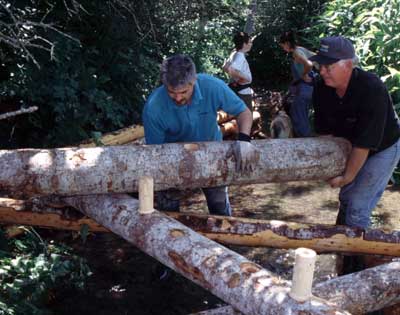Introduction
Depletion and loss of functional large woody debris from streams and rivers of the Pacific Northwest is identified as a contributor to the decline in salmonid populations. Salmon, bull trout, steelhead and other fish are dependent on large woody debris (LWD) and channel morphology resulting from the presence of LWD for many of their instream habitat needs.
LWD provides cover and shelter from predators, stimulates the formation of pools and calm waters, and aids in gravel sorting to provide spawning beds. Historic LWD density in the coastal streams of the Pacific Northwest is approximately one functional LWD key piece per channel width and one wood complex per 7-10 channel widths.
Natural restoration of in stream wood abundance will take decades or centuries in highly degraded systems, particularly those that are just now receiving riparian zone plantings. An ecological engineering approach that is being widely practiced is to import and place functional LWD in streams as a bridging solution. Placed LWD provides habitat, hydraulic and geomorphic benefits in the short term until natural delivery occurs due to channel migration, tree death and wind throw. It is expected that placed LWD will decay to provide fine organic matter and otherwise blend into the natural environment as riparian protection and silvicultural solutions begin to take hold.
Unfortunately, functional LWD is difficult to procure in the quantities required, and is very expensive to transport and place due to its weight. The object of this paper is to introduce an engineered log jam structure that is easy to transport and install by citizen volunteer and conservation crews.
About the Publication
Dooley, J.H. 2001. Technical Background: Engineered Log Jams. Technical Report. Forest Concepts, Federal Way, WA.
Read the full article in PDF format:

